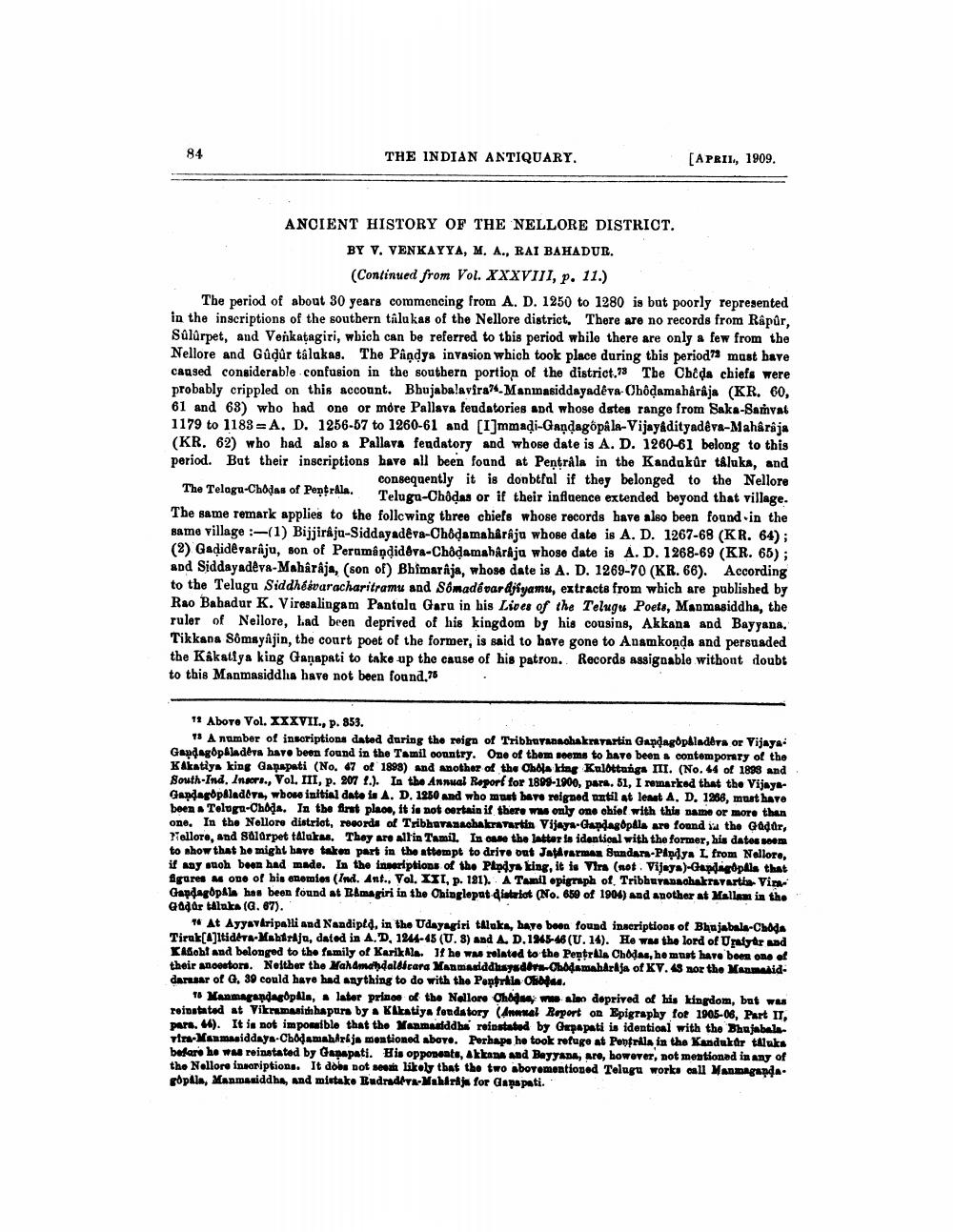________________
84
THE INDIAN ANTIQUARY.
[APRIL, 1909.
ANCIENT HISTORY OF THE NELLORE DISTRICT. BY V. VENKAYYA, M. A., RAI BAHADUR. (Continued from Vol. XXXVIII, p. 11.)
The period of about 30 years commencing from A. D. 1250 to 1280 is but poorly represented in the inscriptions of the southern tâlukas of the Nellore district. There are no records from Râpûr, Sülürpet, and Venkatagiri, which can be referred to this period while there are only a few from the Nellore and Gûdûr tâlukas. The Pandya invasion which took place during this period?3 must have caused considerable confusion in the southern portion of the district.73 The Chĉda chiefs were probably crippled on this account. Bhujabalavira. Manmasiddayadeva Chôḍamahârâja (KR. 60, 61 and 68) who had one or more Pallava feudatories and whose dates range from Saka-Samvat 1179 to 1188 A. D. 1256-57 to 1260-61 and [I]mmadi-Gandagopala-Vijayadityadêva-Maharaja (KR. 62) who had also a Pallava fendatory and whose date is A. D. 1260-61 belong to this period. But their inscriptions have all been found at Pentråla in the Kandukûr taluks, and consequently it is donbtful if they belonged to the Nellore The Telagu-Chodas of Pentrála. Telugu-Chôdas or if their influence extended beyond that village. The same remark applies to the following three chiefs whose records have also been found in the same village :-(1) Bijjiraju-Siddayadêva-Chôḍamahârâju whose date is A. D. 1267-68 (KR. 64); (2) Gaḍidêvaraju, son of Perumândidêva-Chôḍamahârâju whose date is A. D. 1268-69 (KR. 65); and Siddayadeva-Mahârâja, (son of) Bhimarija, whose date is A. D. 1269-70 (KR. 66). According to the Telugu Siddhéévaracharitramu and Somadevar djiyamu, extracts from which are published by Rao Bahadur K. Viresalingam Pantalu Garu in his Lives of the Telugu Poets, Manmasiddha, the ruler of Nellore, Lad been deprived of his kingdom by his cousins, Akkana and Bayyana. Tikkana Somayajin, the court poet of the former, is said to have gone to Anamkonda and persuaded the Kakatiya king Ganapati to take up the cause of his patron. Records assignable without doubt to this Manmasiddha have not been found.75
12 Above Vol. XXXVII., p. 853.
13 A number of inscriptions dated during the reign of Tribhuvanaohakravartin Gandagopaladera or Vijaya: Gandagopaladeva have been found in the Tamil country. One of them seems to have been a contemporary of the Kakatiya king Ganapati (No. 47 of 1898) and another of the Chola king Kulottunga III. (No. 44 of 1898 and South-Ind. Insors., Vol. III, p. 207 1.). In the Annual Report for 1899-1900, para. 51, I remarked that the VijayaGandagopaladeva, whose initial date is A. D. 1250 and who must have reigned until at least A. D. 1266, must have been a Telugu-Choda. In the first place, it is not certain if there was only one chief with this name or more than one. In the Nellore district, records of Tribhuvanachakravartin Vijaya-Gandagopala are found in the Güdür, Nellore, and Salarpet talukas. They are all'in Tamil. In case the latter is identical with the former, his dates seem to show that he might have taken part in the attempt to drive out Jatavarman Sundara-Pindya L from Nellore, if any such been had made. In the inseriptions of the Pandya king, it is Vira (not. Vijaya)-Gandagopala that figures as one of his enemies (Ind. Ant., Vol. XXI, p. 121). A Tamil epigraph of Tribhuvanachakravartia- Vira Gandagopala has been found at Ramagiri in the Chingleput district (No. 650 of 1904) and another at Mallam in the Güdür taluka (G. 67).
14 At Ayyavaripalli and Nandipfd, in the Udayagiri taluka, have been found inscriptions of Bhujabala-Choda Tiruk[A]ltidéra-Maharaja, dated in A.D. 1244-45 (U. 3) and A. D. 1945-46 (U. 14). He was the lord of Uralyar and Kohl and belonged to the family of Karikala. If he was related to the Pentrala Chodas, he must have been one of their ancestors. Neither the Mahamandalbicara Manmasiddhayadeva-Chodamaharaja of KV. 48 nor the Manmasiddarasar of G. 39 could have had anything to do with the Pentrála Chibas.
18 Manmagandagopala, a later prince of the Nellore Chodas, was also deprived of his kingdom, but was reinstated at Vikramasimhapura by a Kakatiya fondatory (Annual Report on Epigraphy for 1905-06, Part II, para. 46). It is not impossible that the Manmasiddha reinstated by Gapapati is identical with the Bhujabala. vira-Manmasiddaya-Chodamahirája mentioned above. Perhaps he took refuge at Pentrála in the Kandukur taluka before he was reinstated by Ganapati. His opponents, Akkana and Bayyana, are, however, not mentioned in any of the Nellore inscriptions. It does not seem likely that the two abovementioned Telugu works call Manmaganda. gopala, Manmasiddha, and mistake Eudradeva-Maharaja for Ganapati.




